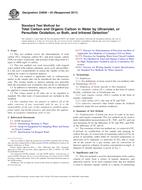We need your consent to use the individual data so that you can see information about your interests, among other things. Click "OK" to give your consent.
ASTM D4839-03(2011)
Standard Test Method for Total Carbon and Organic Carbon in Water by Ultraviolet, or Persulfate Oxidation, or Both, and Infrared Detection
STANDARD published on 1.5.2011
The information about the standard:
Designation standards: ASTM D4839-03(2011)
Note: WITHDRAWN
Publication date standards: 1.5.2011
SKU: NS-28833
The number of pages: 6
Approximate weight : 18 g (0.04 lbs)
Country: American technical standard
Category: Technical standards ASTM
The category - similar standards:
Annotation of standard text ASTM D4839-03(2011) :
Keywords:
carbon, carbon dioxide, low temperature oxidation, organic carbon, total carbon, Carbon content--water, Infrared (IR) analysis--water, Inorganic compounds--water, Low-temperature testing--water, Organic carbon (OC), Organic compounds--water, Oxidation testing, Pollutants, Seawater (natural/synthetic), Total organic carbon (TOC), Wastewater testing/treatment, ICS Number Code 71.060.10 (Chemical elements)
Additional information
| Significance and Use | ||||||||||||||
|
This test method is used for determination of the carbon content of water from a variety of natural, domestic, and industrial sources. In its most common form, this test method is used to measure organic carbon as a means of monitoring organic pollutants in industrial wastewater. These measurements are also used in monitoring waste treatment processes. The relationship of TOC to other water quality parameters such as chemical oxygen demand (COD) and total oxygen demand (TOD) is described in the literature. |
||||||||||||||
| 1. Scope | ||||||||||||||
|
1.1 This test method covers the determination of total carbon (TC), inorganic carbon (IC), and total organic carbon (TOC) in water, wastewater, and seawater in the range from 0.1 mg/L to 4000 mg/L of carbon. 1.2 This test method was used successfully with reagent water spiked with sodium carbonate, acetic acid, and pyridine. It is the user's responsibility to ensure the validity of this test method for waters of untested matrices. 1.3 This test method is applicable only to carbonaceous matter in the sample that can be introduced into the reaction zone. The syringe needle or injector opening size generally limit the maximum size of particles that can be so introduced. 1.4 In addition to laboratory analyses, this test method may be applied to stream monitoring. 1.5 The values stated in SI units are to be regarded as standard. No other units of measurement are included in this standard. 1.6 This standard does not purport to address all of the safety concerns, if any, associated with its use. It is the responsibility of the user of this standard to establish appropriate safety and health practices and determine the applicability of regulatory limitations prior to use. |
||||||||||||||
| 2. Referenced Documents | ||||||||||||||
|
Similar standards:
Historical
1.6.2014
Historical
1.1.2013
Historical
1.5.2010
Historical
1.5.2010
Historical
1.5.2010
Historical
1.5.2010



 ASTM C1415-14
ASTM C1415-14 ASTM C1637-13
ASTM C1637-13 ASTM C560-88(2010)e1..
ASTM C560-88(2010)e1.. ASTM C561-91(2010)e1..
ASTM C561-91(2010)e1.. ASTM C562-91(2010)e1..
ASTM C562-91(2010)e1.. ASTM C565-93(2010)e1..
ASTM C565-93(2010)e1.. Cookies
Cookies
